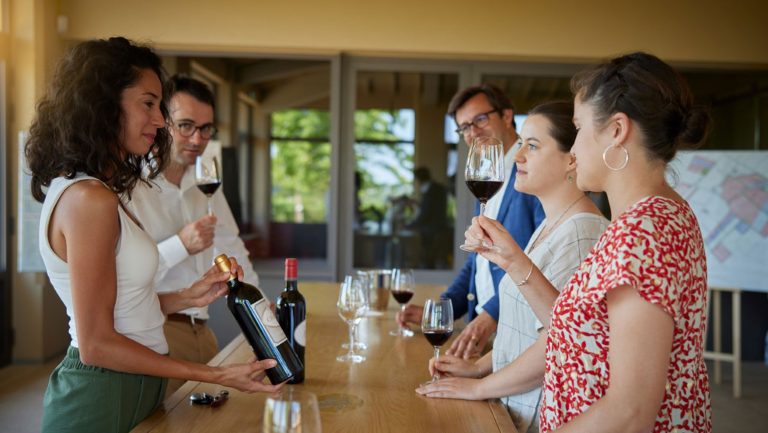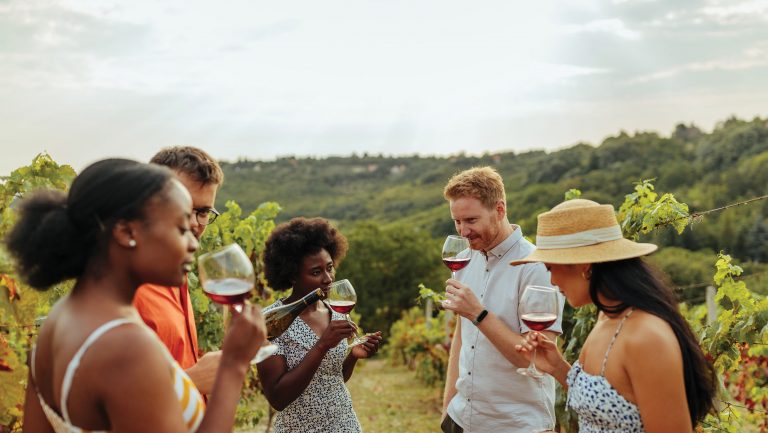“Like most people in Bordeaux, 20 years ago we weren’t open for tourists,” says Michel Marengo, the owner and winemaker of the family-run Château Hourtin-Ducasse, located a five-minute drive inland from such famous first growth estates as Lafite Rothschild, Mouton Rothschild, and Latour. “There existed a certain snobbishness, and people felt like it was a dirty business taking in visitors.”
While Lafite, Latour, and Mouton did accept guests, it was only if they were certified customers of retailers who recommended them by letter or fax well in advance of an audience at the château. First growths simply did not allow everyday tourists to visit.
Yet, by the end of last year, Marengo says, 60 percent of his winery’s revenue came from visitors. Similarly, in 2019, the last year before the pandemic, Bordeaux welcomed 6.8 million tourists according to the Bordeaux office of Great Wine Capitals, three times what it was 15 years earlier, and tourists spent $1.6 billion in the region. Moreover, eight percent of all local jobs now depend directly on tourism. And although an appointment is still necessary at Lafite, Latour, and Mouton, as with most other classified growths, any visitor can make one by following the instructions on their respective websites.

Don’t miss the latest drinks industry news and insights. Sign up for our award-winning newsletters and get insider intel, resources, and trends delivered to your inbox every week.
So, what caused Bordeaux’s about-face from “dirty business” to essential revenue? Twenty years on, we can look back at the making of a wine destination and what impact a colossal increase in tourism has had on the region.
A Late Start in Tourism
It is easy to get lost in the miles of rolling countryside that mark Bordeaux. In addition to the now well-visited Medoc, Graves, and Sauternes on the Left Bank, and Saint-Émilion and Pomerol on the Right Bank, there are the various Côtes de Bordeaux villages, the satellite regions of Saint-Émilion, and the vast Entre-Deux-Mers region between the two banks. There are literally thousands of châteaux—but for many years the region’s reticence towards tourism, poor infrastructure, and lack of a well-appointed hub in Bordeaux city made visiting a trial.
Following the devastation of World War II, when the region was occupied by German troops, there was a scarcity of funds to replant vineyards and rebuild wine cellars. International markets were slow to redevelop and at least half of the vintages during the 1960s were judged substandard. “The 1970s were hard times and renovations needed to be made. While some people opened to sell their wines in the 1980s, wine merchants didn’t like the competition,” says Sylvie Cazes, whose family has owned fifth growth Château Lynch-Bages in Pauillac since 1939.

After the Judgment of Paris in 1976 and the publicity around it, the American market began paying more attention to French wine, with vintages in the late 1970s and 1980s much improved, gaining the attention of wine critic Robert Parker. “Bordeaux became the reference point for the American market, and eventually many came to visit,” says Dominique Renard, who for 30 years was the manager of the Moueix family estates, including Petrus.
The Cazes family became instrumental in shifting Bordeaux’s approach to tourism. “We had the chance to visit the U.S. and see how Napa vintners were so successful in receiving a great number of visitors and how faithful those visitors remained after their experience,” Cazes says. “In France, wine tourism had not started, but we felt that it was essential to create a link with all wine lovers who could come to Bordeaux.”
In the 1980s, the Cazes family opened the newly renovated cellars at Lynch-Bages to visitors—when few others were doing so—and then in 1989, they converted neighboring château Cordeillan-Bages into a luxury hotel with a gourmet restaurant (which went on to earn two Michelin stars). To meet growing demand, in 2005 Sylvie Cazes launched Bordeaux Saveurs, a tourism agency offering bespoke tours and events; and in 2006, with her brother Jean-Michel Cazes, repurposed the four-block village of Bages into a warren of tourist shops and eateries providing much-needed hospitality options.
Even the prestige châteaux realized a strong Bordeaux brand at all levels would further their prosperity. Many now trade on their brand names with popular entry-level wines, as Mouton Rothschild does with its Mouton Cadet line. And, in turn, these popular wines help sponsor tourism events, as Mouton Cadet does with the annual Marathon du Médoc. The marketing concept is that wine drinkers move up the quality ladder as they become more prosperous.
Building Tourism Infrastructure
Word spread across the region that tourists valued wine experiences and offered a potential revenue stream to any châteaux that accommodated them. The jurisdiction of Saint-Émilion was amongst the first to capitalize on wine tourism, with eight villages listed as a UNESCO World Heritage site since 1999. Sauternes followed suit about a dozen years ago when several châteaux, led by Château Guiraud, decided they needed a wine trail to attract visitors and began adding eating and lodging facilities. “Now the town of Sauternes is the latest to embrace visitors, with new hotels, shops and restaurants,” says Cazes.
But even as options opened for visiting châteaux, Bordeaux city remained uninspiring and dilapidated as a destination, which hampered efforts. That changed when Alain Juppé became mayor in 1995 and set about revitalizing the city, setting in motion a period of time in which city and local governments and regional wine associations worked together to create or update the necessary infrastructure to attract visitors.

The culmination of those efforts was the 2016 opening of the $47-million tourism masterpiece La Cité du Vin, a soaring, gleaming—in Juppé’s words—“Guggenheim of wine.” They received 400,000 visitors last year, according to Cazes, who serves as president of its board, with a program of wine-tasting workshops, expositions, and presentations. City officials had observed that, previously, at events such as the annual en primeur trade tastings or the semi-annual Vinexpo there was little to draw visitors to spend time in the city itself; an architecturally stunning wine museum was the answer.
Lesser-Known Estates Step Up to Compete
As wineries at all levels began tapping into the tourism business, smaller wine regions and lesser-known estates, like Hourtin-Ducasse, began innovating to create offerings to compete with the big players, whether in terms of affordability or novelty. Now there are a whole range of wine experiences at every price point, and plenty of rental cars, bikes, and tour guides to access them.
These developments among smaller wineries have been spurred on by Great Wine Capitals, which for two decades has sponsored tourism awards at the regional and international levels and has heavily publicized the winners. This has further encouraged regions within Bordeaux to include tourism incentives in their marketing plans. For example, lesser-known Côtes-de-Bourg opened its own Maison du Vin with a tasting bar and river transportation from downtown Bordeaux, which went on to win a Best of Wine Tourism award from Great Wine Capitals in 2017. “What has evolved in Bordeaux wine tourism in recent years is the hospitality services such as lodging and dining or food with tastings being offered by the châteaux,” says Catherine Leparmentier Dayot, the managing director of Great Wine Capitals.
Armelle Cruse is one of five sisters who inherited Château du Taillan near the Margaux region. “We opened to visitors in 2005 when we created a group with other local women winemakers,” says Cruse. “Taillan was the first château to open during harvest, which is now standard for Bordeaux. People were happy to see what we actually did for a living. And it gave value to workers because visitors were interested in what they did and took photos with them.” Today, tourism makes up 40 percent of Taillan’s income and special events another 10 percent.
Veronique Dausse, the director general of Château Phélan Ségur in Saint-Estèphe, emphasizes the personal touch, a reflection of recent owners being in the luxury hospitality business elsewhere in France. “We were one of the first to have visitors for lunch or dinner tastings,” says Dausse, “and we’ve had a resident chef for 30 years, both for public and the trade. I believe the best way to showcase what we do—our wines—is during a meal. We want to enhance the relationship, and we invest a lot of time and money to do so.”

As Marengo points out, the lesser-known châteaux can offer a different level of intimacy. “If you go visit the big châteaux in Pauillac like Lynch-Bages, Lafite, or Mouton, it’s like going to Disneyworld with all the staff they have available. Here, we’re more the real world,” he says. “But at the same time, both are important. People plan for years to come here, and they want to visit the places they’ve read about. But they also want to see how things are done at places like ours, to drink wine on the barrel head in an informal situation.”
Looking ahead, Bordeaux is focused on sustainability. By 2030, all winegrowers must adopt a certified environmental approach to meet the specifications of the Bordeaux AOC. Its efforts were rewarded in 2022, when Bordeaux was named a European Capital of Smart Tourism by the European Commission and specifically lauded for pioneering sustainable wine tourism—the same year the Bordeaux Wine Festival was certified sustainable. All these measures are working toward the longevity of both the wine industry and its capacity for tourism.

Dispatch
Sign up for our award-winning newsletter
Don’t miss the latest drinks industry news and insights—delivered to your inbox every week.
Roger Morris is a Delaware-based writer who for the past 20 years has contributed articles on wine, food, and popular culture to about a dozen publications in the U.S. and Europe. Currently, he writes for World of Fine Wine, Drinks Business, Meininger’s, VinePair, Wine & Spirits, and Global Drinks Intel, among others. In prior years, he taught writing at Arizona State University and the University of Delaware and was an industry marketing executive.






